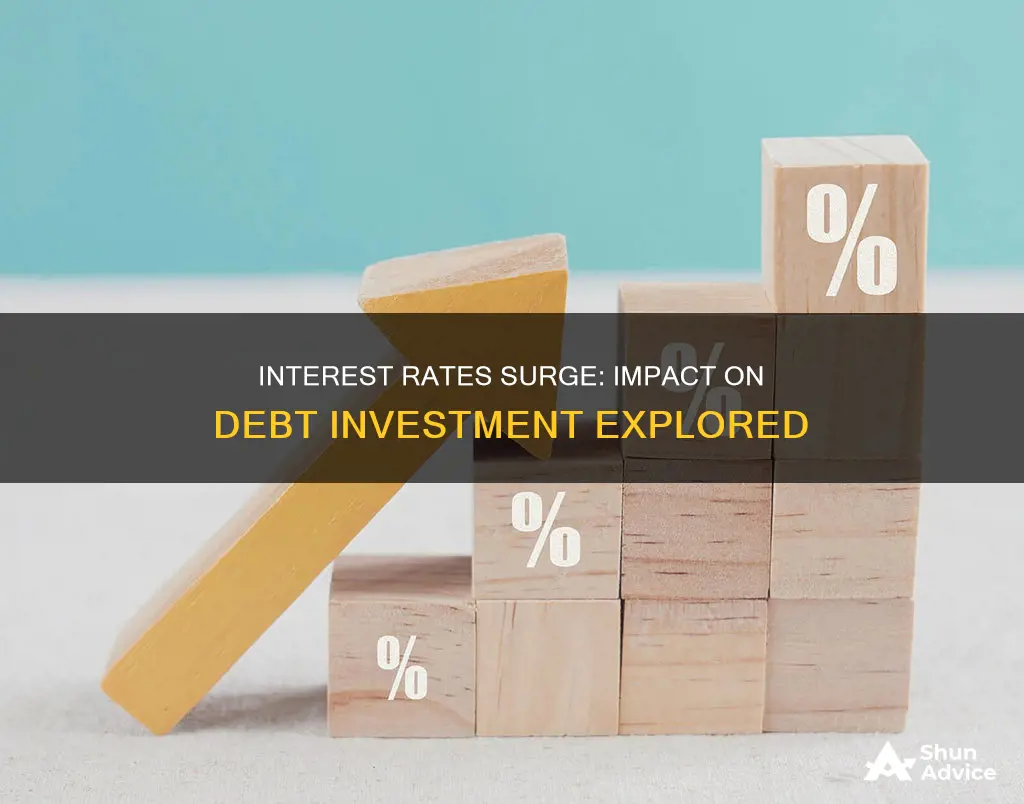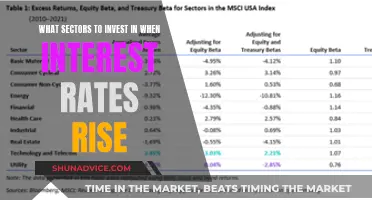
Rising interest rates can have a significant impact on debt investment. When interest rates rise, it becomes more expensive to borrow money, leading to higher monthly payments for those with debt. This can also affect companies' bottom lines, as they may face higher borrowing costs, resulting in reduced profits and lower stock prices. On the other hand, rising interest rates can make bonds a more attractive investment option, as they offer higher yields. This can put pressure on stock valuations, as corporations may need to generate more attractive earnings to capture investor interest. Overall, rising interest rates can have both positive and negative effects on debt investment, depending on the specific circumstances.
| Characteristics | Values |
|---|---|
| Effect on monthly payments | When interest rates rise, it becomes more expensive to borrow money, resulting in higher monthly payments. Conversely, when rates fall, borrowing becomes cheaper, leading to lower monthly payments. |
| Total amount of debt | Rising interest rates increase the total amount of debt paid on any new debt. Conversely, falling interest rates reduce the overall debt burden. |
| Investor behaviour | Rising interest rates may prompt investors to shift their focus from stocks to bonds, which offer more attractive yields. This can put pressure on stock valuations as companies strive to generate more appealing earnings. |
| Company profits | Higher interest rates can lead to reduced company profits, particularly for debt-issuing companies that face increased borrowing costs. This, in turn, can result in lower stock prices. |
| Capital raising | Interest rate hikes make it more expensive for companies to raise capital, impacting their growth prospects and near-term earnings. |
| Bond advantages | Bonds purchased after interest rates have risen may offer larger income streams and be subject to reduced interest rate risk. |
| Revolving or variable-rate debts | Interest rate changes have an immediate effect on revolving or variable-rate debts, such as credit cards. |
What You'll Learn

How rising interest rates affect monthly payments
Rising interest rates have a direct impact on monthly payments for debt investments. When interest rates increase, it becomes more expensive to borrow money, resulting in higher monthly payments. This effect is most noticeable for individuals or entities with revolving or variable-rate debts, such as credit cards, as interest rate changes have an immediate impact on these types of debts.
For example, if you have a credit card with a variable interest rate, an increase in interest rates will lead to a higher monthly payment. This is because the credit card company will charge you more interest on the outstanding balance, increasing your overall monthly expense.
Similarly, for individuals with mortgages, auto loans, or personal loans, rising interest rates will result in higher monthly payments. This is because the cost of borrowing increases, and this additional expense is reflected in the monthly instalments.
The impact of rising interest rates on monthly payments can also be observed in the stock market. When interest rates rise, companies face higher borrowing costs, which can affect their future growth prospects and near-term earnings. As a result, investors may choose to invest in bonds that offer more attractive yields rather than stocks. This shift in investment preferences can put pressure on stock valuations, potentially leading to lower stock prices.
However, it is important to note that rising interest rates can also create opportunities for debt investment. After interest rates have risen, purchasing bonds may generate a larger income stream and may be subject to less interest rate risk. This is because there is a reduced chance of interest rates moving significantly higher from the current levels.
Interest Rates: Impact on Investment Spending and the Economy
You may want to see also

How rising interest rates affect the total amount of debt
Rising interest rates have a direct impact on the total amount of debt. When interest rates increase, it becomes more expensive to borrow money, leading to higher monthly payments. This effect is particularly noticeable for individuals with revolving or variable-rate debts, such as credit cards. As a result, the total amount of debt paid on any new debt increases.
For example, if an individual has a credit card with a variable interest rate, an increase in interest rates will lead to a higher monthly payment. This means that they will be paying more in interest charges over time, increasing the total cost of their debt.
Similarly, companies that issue debt, such as bonds, will also face higher borrowing costs. This can impact their future growth prospects and near-term earnings. As a result, investors may choose to invest in these bonds instead of stocks, as they offer more attractive yields.
However, there are also advantages to purchasing bonds after interest rates have risen. These bonds may generate a larger income stream and be subject to less interest rate risk, as there is a reduced chance of rates increasing further.
Overall, rising interest rates can significantly impact the total amount of debt for both individuals and companies. It becomes more expensive to borrow, leading to higher monthly payments and an increased total cost of debt.
Understanding the Correlation Between Interest Rates and Investments
You may want to see also

How rising interest rates affect stock markets
Rising interest rates can affect stock markets in several ways. Firstly, when interest rates rise, it becomes more expensive for companies to raise capital. This is because they will have to pay higher interest rates on the bonds they issue. This can hurt a company's future growth prospects and its near-term earnings. As a result, there may be a downward revision in profit expectations for the future. This will lower the price of the company's stock.
Secondly, higher interest rates can put pressure on stock valuations. This is because corporations may need to generate more attractive earnings to capture investor interest. If a debt-issuing company faces higher borrowing costs due to rising rates, it may result in reduced company profits, which can be reflected in lower stock prices.
Thirdly, rising interest rates can make equities less attractive to investors. This is because investors may choose to invest in bonds that offer more attractive yields than stocks. This can lead to a decrease in demand for stocks, further lowering stock prices.
Overall, rising interest rates can have a negative impact on stock markets by increasing the cost of capital for companies, putting pressure on stock valuations, and reducing demand for equities. However, it is important to note that the impact of rising interest rates on stock markets can be complex and may depend on various other economic factors.
The Magic of Compound Interest for Long-Term Investments
You may want to see also

How rising interest rates affect company growth
Rising interest rates can affect company growth in several ways. Firstly, they make it more expensive for companies to borrow money, which can hurt their future growth prospects and near-term earnings. This is because companies will have to pay higher interest rates on the bonds they issue, for example. As a result, there may be a downward revision in profit expectations for the future. If a company is seen as cutting back on its growth or becoming less profitable, the estimated amount of future cash flows will drop, and this will lower the price of the company's stock.
Additionally, rising interest rates can put pressure on stock valuations as corporations may need to generate more attractive earnings to capture investor interest. Investors may choose to invest in bonds that pay more attractive yields than stocks, which can further challenge equities and affect stock markets.
On the other hand, rising interest rates can also have some advantages for companies. For instance, purchasing bonds after interest rates have risen can generate a larger income stream and may be subject to less interest rate risk as there is a reduced chance of rates moving significantly higher.
Overall, while rising interest rates can increase borrowing costs and impact company growth, they can also create opportunities for companies to generate higher income through bond investments and benefit from reduced interest rate risk.
Interest Rate Changes: Impact on Consumption and Investment Decisions
You may want to see also

How rising interest rates affect the affordability of large purchases
Rising interest rates can make it more difficult to afford large purchases, such as a car, a house, or college tuition. This is because when interest rates rise, it becomes more expensive to borrow money. This increase in the cost of borrowing is reflected in higher monthly payments. For example, if you take out a loan to buy a car, a higher interest rate will result in a higher monthly payment.
The impact of rising interest rates on the affordability of large purchases can be seen in two primary ways. Firstly, and most noticeably, it affects your monthly payments. When interest rates rise, it becomes more expensive to borrow money, and this increased cost is reflected in higher monthly payments. Conversely, when interest rates fall, borrowing becomes cheaper, and your monthly payments decrease.
Secondly, rising interest rates increase the total amount of debt you will pay over the life of any new debt. This effect may not be as immediately obvious, but it is important to consider. For example, if you take out a mortgage to buy a house, a higher interest rate will not only increase your monthly payments but also the total amount of debt you will pay over the life of the loan.
The impact of rising interest rates on the affordability of large purchases can also be seen in the stock market. When interest rates rise, it becomes more expensive for companies to raise capital, as they will have to pay higher interest rates on the bonds they issue. This can hurt their future growth prospects and near-term earnings, leading to a downward revision in profit expectations. As a result, the price of the company's stock may decrease, making it less attractive to investors.
However, there can be advantages to purchasing bonds after interest rates have risen. Bonds purchased at higher interest rates may generate a larger income stream and be subject to less interest rate risk, as there may be a reduced chance of rates moving significantly higher in the future.
Investment Interest Expenses: Are They Taxable?
You may want to see also
Frequently asked questions
When interest rates rise, it is more expensive to borrow money, which means you will have to pay a higher monthly payment.
When interest rates rise, the total amount of debt you pay on any new debt increases.
If a company is facing higher borrowing costs due to rising interest rates, it may result in reduced company profits, which can be reflected in lower stock prices.
When interest rates rise, investors may choose to invest in bonds that pay more attractive yields than stocks. This can put pressure on stock valuations, as corporations may need to generate more attractive earnings to capture investor interest.







